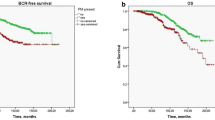Abstract
Purpose
This study was designed to determine whether perineural invasion (PNI) and lymphovascular invasion (LVI) are independent predictors for biochemical recurrence (BCR) of prostate cancer (PCa) following radical prostatectomy (RP) in the Asian population.
Methods
The study population comprised 2394 PCa patients undergoing RP at our institution in Korea. After excluding 360 patients, we compared the baseline characteristics between the groups according to the presence of PNI or LVI and estimated BCR-free survival using the Kaplan–Meier survival. Multivariate Cox regression model was adopted to identify significant predictive factors of BCR following RP.
Results
Among 2034 patients, PNI and LVI were detected in 69.3 and 12.4 % patients, respectively. Patients with PNI or LVI had higher rates of advanced biopsy and pathological Gleason score (≥7), and higher proportions of advanced clinical and pathological T stage ≥3, extraprostatic extension, seminal vesicle invasion, and surgical margin positivity. Notably, BCR-free survival was lower in patients with PNI or LVI compared with that in patients without these markers and lower in patients with both markers compared with that in other populations of patients. Moreover, PNI (hazard ratio [HR] = 2.11) and LVI (HR = 1.57) were significant predictors of BCR. The presence of the two markers was associated with a higher risk of BCR (HR = 4.60) compared with the presence of either marker alone (HR = 3.47).
Conclusions
PNI and LVI are adverse pathologic parameters and independent predictors for BCR, and the concurrent presence of PNI and LVI resulted in poorer outcomes for BCR in PCa patients who underwent RP.



Similar content being viewed by others
References
Rosenbaum E, Partin A, Eisenberger MA. Biochemical relapse after primary treatment for prostate cancer: studies on natural history and therapeutic considerations. J Natl Compr Cancer Netw. 2004;2(3):249–56.
Kang M, Jeong CW, Choi WS, Park YH, Cho SY, Lee S, et al. Pre- and post-operative nomograms to predict recurrence-free probability in korean men with clinically localized prostate cancer. PloS One. 2014;9(6):e100053. doi:10.1371/journal.pone.0100053.
Kotb AF, Elabbady AA. Prognostic factors for the development of biochemical recurrence after radical prostatectomy. Prostate Cancer. 2011;2011:485189. doi:10.1155/2011/485189.
Katz B, Srougi M, Dall’Oglio M, Nesrallah AJ, Sant’anna AC, Pontes J, Jr., et al. Perineural invasion detection in prostate biopsy is related to recurrence-free survival in patients submitted to radical prostatectomy. Urol Oncol. 2013;31(2):175-9. doi:10.1016/j.urolonc.2010.11.008.
Reeves F, Hovens CM, Harewood L, Battye S, Peters JS, Costello AJ, et al. Does perineural invasion in a radical prostatectomy specimen predict biochemical recurrence in men with prostate cancer? Can Urol Assoc J. 2015;9(5–6):E252-5. doi:10.5489/cuaj.2619.
Loeb S, Roehl KA, Yu X, Antenor JA, Han M, Gashti SN, et al. Lymphovascular invasion in radical prostatectomy specimens: prediction of adverse pathologic features and biochemical progression. Urology. 2006;68(1):99–103. doi:10.1016/j.urology.2006.02.004.
Ng J, Mahmud A, Bass B, Brundage M. Prognostic significance of lymphovascular invasion in radical prostatectomy specimens. BJU Int. 2012;110(10):1507–14. doi:10.1111/j.1464-410X.2012.11115.x.
Mitsuzuka K, Narita S, Koie T, Kaiho Y, Tsuchiya N, Yoneyama T, et al. Lymphovascular invasion is significantly associated with biochemical relapse after radical prostatectomy even in patients with pT2N0 negative resection margin. Prostate Cancer Prostatic Dis. 2015;18(1):25–30. doi:10.1038/pcan.2014.40.
Edge SB, Compton CC. The American Joint Committee on Cancer: the 7th edition of the AJCC cancer staging manual and the future of TNM. Ann Surg Oncol. 2010;17(6):1471–4. doi:10.1245/s10434-010-0985-4.
Epstein JI, Allsbrook WC, Jr., Amin MB, Egevad LL, Committee IG. The 2005 International Society of Urological Pathology (ISUP) Consensus Conference on Gleason Grading of Prostatic Carcinoma. Am J Surg Pathol. 2005;29(9):1228–42.
Liebig C, Ayala G, Wilks JA, Berger DH, Albo D. Perineural invasion in cancer: a review of the literature. Cancer. 2009;115(15):3379–91. doi:10.1002/cncr.24396.
Magi-Galluzzi C, Evans AJ, Delahunt B, Epstein JI, Griffiths DF, van der Kwast TH, et al. International Society of Urological Pathology (ISUP) Consensus Conference on Handling and Staging of Radical Prostatectomy Specimens. Working group 3: extraprostatic extension, lymphovascular invasion and locally advanced disease. Mod Pathol. 2011;24(1):26–38. doi:10.1038/modpathol.2010.158.
Stephenson AJ, Kattan MW, Eastham JA, Dotan ZA, Bianco FJ, Jr., Lilja H, et al. Defining biochemical recurrence of prostate cancer after radical prostatectomy: a proposal for a standardized definition. J Clin Oncol. 2006;24(24):3973–8. doi:10.1200/JCO.2005.04.0756.
Noble JH, Jr. Declaration of Helsinki. Dead. BMJ. 2007;335(7623):736. doi:10.1136/bmj.39360.415833.BE.
Fine SW, Amin MB, Berney DM, Bjartell A, Egevad L, Epstein JI, et al. A contemporary update on pathology reporting for prostate cancer: biopsy and radical prostatectomy specimens. Eur Urol. 2012;62(1):20–39. doi:10.1016/j.eururo.2012.02.055.
Jung JH, Lee JW, Arkoncel FR, Cho NH, Yusoff NA, Kim KJ, et al. Significance of perineural invasion, lymphovascular invasion, and high-grade prostatic intraepithelial neoplasia in robot-assisted laparoscopic radical prostatectomy. Ann Surg Oncol. 2011;18(13):3828–32. doi:10.1245/s10434-011-1790-4.
Ozcan F. Correlation of perineural invasion on radical prostatectomy specimens with other pathologic prognostic factors and PSA failure. Eur Urol. 2001;40(3):308–12. doi:10.1159/000049791.
Jeon HG, Bae J, Yi JS, Hwang IS, Lee SE, Lee E. Perineural invasion is a prognostic factor for biochemical failure after radical prostatectomy. Int J Urol. 2009;16(8):682–6. doi:10.1111/j.1442-2042.2009.02331.x.
Fromont G, Godet J, Pires C, Yacoub M, Dore B, Irani J. Biological significance of perineural invasion (PNI) in prostate cancer. Prostate. 2012;72(5):542–8. doi:10.1002/pros.21456.
Ciftci S, Yilmaz H, Ciftci E, Simsek E, Ustuner M, Yavuz U, et al. Perineural invasion in prostate biopsy specimens is associated with increased bone metastasis in prostate cancer. Prostate. 2015;75(15):1783–9. doi:10.1002/pros.23067.
Yee DS, Shariat SF, Lowrance WT, Maschino AC, Savage CJ, Cronin AM, et al. Prognostic significance of lymphovascular invasion in radical prostatectomy specimens. BJU Int. 2011;108(4):502–7. doi:10.1111/j.1464-410X.2010.09848.x.
Author information
Authors and Affiliations
Corresponding author
Electronic supplementary material
Below is the link to the electronic supplementary material.
10434_2016_5153_MOESM1_ESM.tif
Fig. S1. Kaplan-Meier survival analysis for biochemical recurrence (BCR) following radical prostatectomy (RP) in patients with prostate cancer (PCa), according to the presence of high-grade prostatic intraepithelial neoplasm. Log-rank test was used for determining the statistical significance between the groups (TIF 21 kb)
Rights and permissions
About this article
Cite this article
Kang, M., Oh, J.J., Lee, S. et al. Perineural Invasion and Lymphovascular Invasion are Associated with Increased Risk of Biochemical Recurrence in Patients Undergoing Radical Prostatectomy. Ann Surg Oncol 23, 2699–2706 (2016). https://doi.org/10.1245/s10434-016-5153-z
Received:
Published:
Issue Date:
DOI: https://doi.org/10.1245/s10434-016-5153-z




